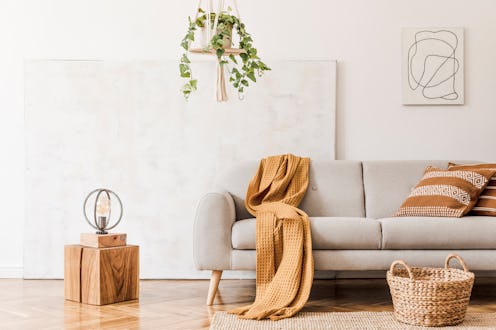(Living)
This Interior Designer-Approved Tip Can Upgrade Your Space In The Most Sustainable Way

Turns out your closet isn't the only space in your home that could use a little revamping if you've got environmental concerns: With brands and designers taking note of the need for change, it's becoming easier and more accessible to decorate your place in more eco-friendly ways. And according to interior designers, the most sustainable home decor ideas don't always involve spending more, so it's an ideal time to consider giving your pad a green makeover.
Sustainability has certainly become a buzzword across many industries — and the concept of greenwashing is very real — so it's easy to feel lost when you're trying to determine what products and practices are legitimately more earth-friendly. But when it comes to your home decor, experts have taken note of this trend (as well as the increasing demand from clients) and have given serious consideration to the issue. And because of that, who better to consult with questions about where and what to buy (or not to buy, as the case may be) if you're trying to steer your home in a more sustainable direction?
Sybille Zimmermann, Founder and Interior Architect of Studio Zimmermann, is one such interior expert who's had to reevaluate design with respect to concerns about sustainability. While some of the tips she's gathered involve products to purchase (such as paint, fabric, and furniture) — even if they're not necessarily more expensive than their alternatives — others are more of a lifestyle change. Curious to know if you're doing all you can to make your home a more environmentally friendly place to live? Read ahead for Zimmermann's five best practices that will totally change how you think about home decor.
Buy Fewer, But Better
Just like fashion experts suggest in terms of curating your closet, Zimmermann believes the most sustainable way to decorate your home involves shopping for pieces that will last, instead of based on trends. "Growing up in Switzerland, I came from a culture that invests in quality pieces that last for generations," she says. "Here in the U.S., everything is disposable, even decor for your home. I think a home should tell a story, and that story is best told through pieces that last. For budget conscious clients, I always recommend to buy less and buy better which, to me, is at the center of sustainability."
Reupholster Before You Replace
In the interest of giving more mileage to your furniture pieces — versus constantly ditching them for something new — Zimmermann recommends reupholstering. There's less waste, plus you'll still get the refresh you're looking for.
Shop Secondhand
And if you do wish to shop for "new" pieces, don't discount the gems that can be found secondhand. "We're big into sourcing vintage and going to local flea markets and 'hole in the wall' thrift shops," says Zimmermann. "You never know what you will find!" That said, if you have to buy something contemporary, you can do so more sustainably by utilizing local vendors, artists, and craftsmen, as the interior expert suggests.
Swap In Eco-Friendly Materials When Possible
Even big box home decor brands are rethinking their materials and offering more options for their conscious customers. Opt for natural fibers and dyes when possible (ie: jute, hemp, organic cotton and linen) and look for recycled/reclaimed materials as well. And you can even make your paint more sustainable as well. "Using non-toxic paint is important for both the environment and its inhabitants," Zimmermann says. "Nowadays, most paint companies offer a natural option, such as Benjamin Moore's Natura." Backdrop and Portola are a few other brands that specialize in this.
This article was originally published on